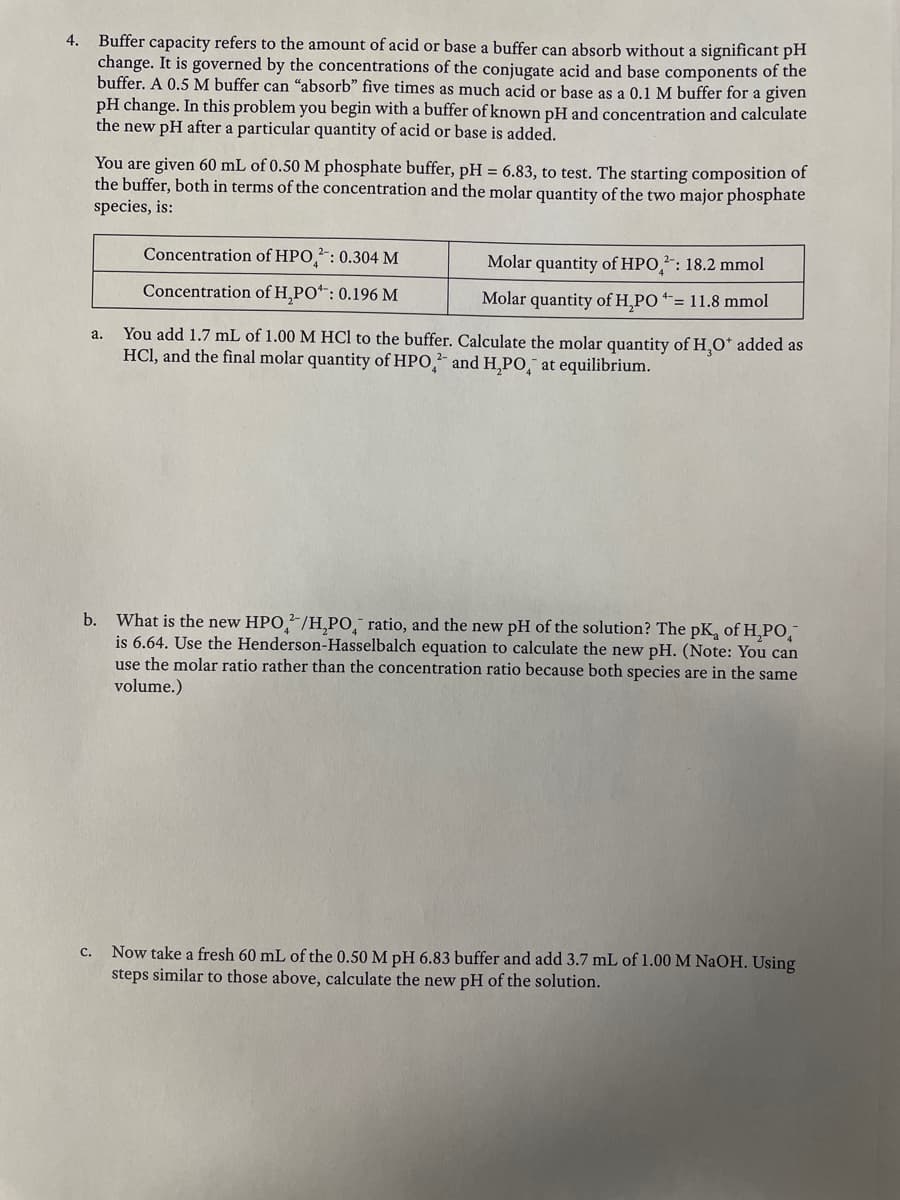You are given 60 mL of 0.50 M phosphate buffer, pH = 6.83, to test. The starting composition of the buffer, both in terms of the concentration and the molar quantity of the two major phosphate species, is: %3D Concentration of HPO,: 0.304 M Molar quantity of HPO: 18.2 mmol Concentration of H,PO“: 0.196 M Molar quantity of H,PO = 11.8 mmol You add 1.7 mL of 1.00 M HCl to the buffer. Calculate the molar quantity of H,O* added as HCl, and the final molar quantity of HPO, and H,PO,¯ at equilibrium. а.
You are given 60 mL of 0.50 M phosphate buffer, pH = 6.83, to test. The starting composition of the buffer, both in terms of the concentration and the molar quantity of the two major phosphate species, is: %3D Concentration of HPO,: 0.304 M Molar quantity of HPO: 18.2 mmol Concentration of H,PO“: 0.196 M Molar quantity of H,PO = 11.8 mmol You add 1.7 mL of 1.00 M HCl to the buffer. Calculate the molar quantity of H,O* added as HCl, and the final molar quantity of HPO, and H,PO,¯ at equilibrium. а.
Chemistry: Principles and Practice
3rd Edition
ISBN:9780534420123
Author:Daniel L. Reger, Scott R. Goode, David W. Ball, Edward Mercer
Publisher:Daniel L. Reger, Scott R. Goode, David W. Ball, Edward Mercer
Chapter16: Reactions Between Acids And Bases
Section: Chapter Questions
Problem 16.78QE
Related questions
Question
100%

Transcribed Image Text:Buffer capacity refers to the amount of acid or base a buffer can absorb without a significant pH
change. It is governed by the concentrations of the conjugate acid and base components of the
buffer. A 0.5 M buffer can "absorb" five times as much acid or base as a 0.1 M buffer for a given
pH change. In this problem you begin with a buffer of known pH and concentration and calculate
the new pH after a particular quantity of acid or base is added.
4.
You are given 60 mL of 0.50 M phosphate buffer, pH = 6.83, to test. The starting composition of
the buffer, both in terms of the concentration and the molar quantity of the two major phosphate
species, is:
Concentration of HPO,²: 0.304 M
Molar quantity of HPO,: 18.2 mmol
Concentration of H,PO*: 0.196 M
Molar quantity of H,PO = 11.8 mmol
You add 1.7 mL of 1.00 M HCl to the buffer. Calculate the molar quantity of H,O* added as
HCl, and the final molar quantity of HPO, and H,PO,¯ at equilibrium.
a.
b. What is the new HPO/H,PO,¯ ratio, and the new pH of the solution? The pK, of H,Po,
is 6.64. Use the Henderson-Hasselbalch equation to calculate the new pH. (Note: You can
use the molar ratio rather than the concentration ratio because both species are in the same
volume.)
Now take a fresh 60 mL of the 0.50 M pH 6.83 buffer and add 3.7 mL of 1.00 M NaOH. Using
steps similar to those above, calculate the new pH of the solution.
с.
Expert Solution
This question has been solved!
Explore an expertly crafted, step-by-step solution for a thorough understanding of key concepts.
This is a popular solution!
Trending now
This is a popular solution!
Step by step
Solved in 5 steps

Recommended textbooks for you

Chemistry: Principles and Practice
Chemistry
ISBN:
9780534420123
Author:
Daniel L. Reger, Scott R. Goode, David W. Ball, Edward Mercer
Publisher:
Cengage Learning

Principles of Modern Chemistry
Chemistry
ISBN:
9781305079113
Author:
David W. Oxtoby, H. Pat Gillis, Laurie J. Butler
Publisher:
Cengage Learning

Chemistry: The Molecular Science
Chemistry
ISBN:
9781285199047
Author:
John W. Moore, Conrad L. Stanitski
Publisher:
Cengage Learning

Chemistry: Principles and Practice
Chemistry
ISBN:
9780534420123
Author:
Daniel L. Reger, Scott R. Goode, David W. Ball, Edward Mercer
Publisher:
Cengage Learning

Principles of Modern Chemistry
Chemistry
ISBN:
9781305079113
Author:
David W. Oxtoby, H. Pat Gillis, Laurie J. Butler
Publisher:
Cengage Learning

Chemistry: The Molecular Science
Chemistry
ISBN:
9781285199047
Author:
John W. Moore, Conrad L. Stanitski
Publisher:
Cengage Learning

Chemistry: Principles and Reactions
Chemistry
ISBN:
9781305079373
Author:
William L. Masterton, Cecile N. Hurley
Publisher:
Cengage Learning


Chemistry: An Atoms First Approach
Chemistry
ISBN:
9781305079243
Author:
Steven S. Zumdahl, Susan A. Zumdahl
Publisher:
Cengage Learning